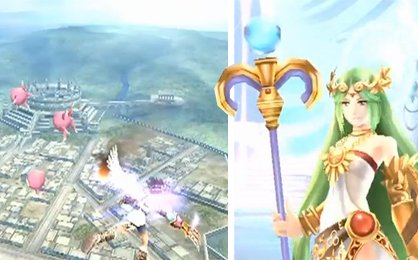How powerful is the 3DS - and more importantly, who cares?
Stop spoiling the awesome with meaningless numbers!
But no more.I have a personal plea for all the people like me, in one very specific instance - stop analysingthe 3DS.
Nintendo's new machine is beautiful. It's turning some of the greatest games ever made into worlds so real you feel you could reach out and touch them. It's got Kid Icarus soaring through blue skies way above a city basking in the heat from the blazing sun... look:

Look at that princess. Look at the expression in her face. Her flowing hair, the curve of her hip. What can we do to shatter this vision of beauty?Turn her into numbers!

Above: The supposed specs of 3DS's processor. In Japanese. Exciting?
Sites likegeeky-gadgetshave been reporting the machine's architecture as having a DMP PICA200 graphics chip with a clock speed of 200MHz, which can display up to 15.3 million polygons per second, 800 million pixels and full screen anti-aliasing. Sounds great. Means nothing. Especially as all of the above is at 'peak performance', and therefore never going to feature exactly in any retail game.
In the days of PSone, it did matter how many polygons per second a machine could do - it was the difference between F1 cars having suspension rods or just wheels that weren't attached to anything. But after Dreamcast passed 1million polys a second and people started talking about floating points instead, it all started to get a bit pointless keeping count.
With PS2 or Gamecube,as long as developers didn't try and do things like fully 3D grass in a football game or thousands of on-screen characters at once, they could make pretty much whatever they wanted - and that's good enough.
Sign up to the GamesRadar+ Newsletter
Weekly digests, tales from the communities you love, and more

Above: Project Gotham Racing 3. Do you need to see the techy stuff?
After graphics have passed the 'Oh, that's supposed to be Mario' stage and reached the 'Mario looks cool' stage, there's no real need to go into detail about the tech, especially on a handheld. Not unless you're a PC gamer who would commit suicide if his rig didn't run Crysis on top settings at 300fps.So seeing sites likedefconawesomesaying:
"Not surprisingly, the GPU utilizes OpenGL ES and support 32 and 16 bit PNG pixel formats, like a lot of portable devices.Also, DMP’s technology includes a lot of ‘on-board’ rendering capabilities.Certain particle, skinning, and shading rendering functions are integrated, making it a much more robust system."
...feels a bit insulting to Nintendo. Is this really all we gamers care about?

At the end of the day, it's about what developers choose to do with the machine. Remember how everybody declared the PSP/DS race over before it had even begun, in favour of the Sony machine? Having the best specs does not equate to the best experience for the gamer, as the last five years have shown.
Even after rendering everything twice to create the 3D effect, 3DS still has the grunt to achieve Gamecube quality graphics.That's all the information you need. I mean,at this stage I don't know how the 3D screen tech really works. But I'm glad. I don't want to be the cynical guy who kills ET and cuts him up on the autopsy table to find out what does what.
I want to see his finger light up.
23 Jun, 2010
Justin was a GamesRadar staffer for 10 years but is now a freelancer, musician and videographer. He's big on retro, Sega and racing games (especially retro Sega racing games) and currently also writes for Play Magazine, Traxion.gg, PC Gamer and TopTenReviews, as well as running his own YouTube channel. Having learned to love all platforms equally after Sega left the hardware industry (sniff), his favourite games include Christmas NiGHTS into Dreams, Zelda BotW, Sea of Thieves, Sega Rally Championship and Treasure Island Dizzy.



